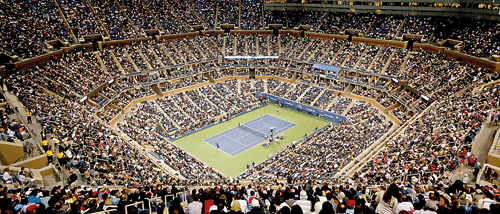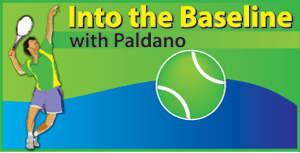US-Open 2017 and Tennis’ Popularity
View(s): The dominant players in the last decade are Rafael Nadal, Roger Federer, Novak Djokovic and Stanislas Wawrinka. Between them, they have won 45 of the 50 big events in that period. This year, the top of the ranking has not been stable in the Men’s, and it is most unstable in the Women’s. It is in this backdrop that the last Grand Slam of the year, the US-Open, will begin tomorrow.
The dominant players in the last decade are Rafael Nadal, Roger Federer, Novak Djokovic and Stanislas Wawrinka. Between them, they have won 45 of the 50 big events in that period. This year, the top of the ranking has not been stable in the Men’s, and it is most unstable in the Women’s. It is in this backdrop that the last Grand Slam of the year, the US-Open, will begin tomorrow.
Women
The current top 4 are Karolina Pliskova, Simona Halep, Garbine Muguruza who is in great form and Elina Svitolina. There are 5 who can easily topple these 4 in the US-Open. They are Caroline Wozniacki, Angelique Kerber, Johanna Konta, Svetlana Kuznetzova and Venus Williams. Jelena Osterpenko is another possibility. Adding to this are the new generation players who will show up at the US-Open.
Men
Nadal is No.1 again but, it has happened because the other 3 did not perform. Murray has been out for a while, Roger Federer physically strained and very selective in what and when he plays, and Wawrinka is also in the injured list. It is not the most attractive big 4 on paper. The 4 others using this situation well in the current US-Open Series are Alexander Zverev, Grigor Dimitrov, Dominic Thiem and Marin Cilic who won the US-Open a few years back.
New generation
In the ATP and WTA rankings, the top 500 has over 25 players under 18 years, similar numbers under 20 and 22. It is surprising how young these players reach the top 500. Every one of them is a potential threat to the top 50 players in the early rounds of any event. For the US-Open, the cutoff ranking mark for direct entry into the main draw is around 160, and only 128 will be permitted into the draw.
The venue
The hard courts of the US-Open at the National Tennis Center in Flushing Meadow, is a state-of-the-art setup. The addition of a public entertainment programme at the venue plays a big role, and attracts a large crowd. Cameras often capture the audience in the stadium courts as part of the broadcast. The covered court permits non-stop telecast, even if it rains. Big screen in the venue has become an additional audience interest. There is a whisper it could have seating accommodation in the near future.
As for the game for the hard court players with good net game or, with the ability to go to the net, will have good prospects to win. The new player development plan worldwide has incorporated the net game with profound emphasis. The ‘blue courts’ of the US-Open series gives better visibility for playing. At one stage, the US-Open was a grass court event in Forest Hills, New York. Some even now say the US should have stayed with Grass. If anything is lacking in the form of attraction, the size of the prize money will compensate it. This year’s US-Open prize money is US$ 50 million!
Popularity of Tennis
There are many sports with regional and traditional popularity, but only a few have global popularity and mass participation. Tennis is one of those few. Over 200 countries have accommodated the changes and challenges to sustain the interest in Tennis over 150 years. In countries which did not accommodated the changes, Tennis has become a school activity and their players are not seen in the Open Tennis arena.
In the regions which produce good players, one could see that local Tennis challenges are well met in administration, facilities and also in events. Popularity of Tennis, for that matter Sport, is a barometer of a nation’s efficiency, stability and progress today.
FIS & P&TS categories
 Free Independent Sport [FIS] have the advantage over Partner & Team Sport [P&TS] in development and in public participation. In today’s world, movement of people is difficult, and free time is not easily found. Due to this, it has become extremely difficult to bring people together for sport. In this situation, FIS has a edge over the others.
Free Independent Sport [FIS] have the advantage over Partner & Team Sport [P&TS] in development and in public participation. In today’s world, movement of people is difficult, and free time is not easily found. Due to this, it has become extremely difficult to bring people together for sport. In this situation, FIS has a edge over the others.
Facilities in countries which had Tennis well established once, now shows a decline, and in the availability of courts to ‘play’ Tennis. In a study of player development, the case of Ana Ivanovic of Serbia is often cited. She had her playing facility walking distance from home. While she had everything else she needed the availability of the courts. It is considered to be the critical factor for her success. Nations will have to address this issue, if not methods of development will be for economic gain and not for full fledged player development or, recreation participation.
A road map
Most of the time, the secret of sustaining Tennis in a nation is very simple. In fact, it is too simple. This is where the error is occurring. Many countries are going towards high end facilities for sponsorship based mega activities. The end result is they are missing out the grass root requirement of making Tennis accessible to people. It is at grass root level level the game grows and nations achieve maturity.
All we have to do is to see the draw sheet of this year’s US-Open and one would see which regions of the world has the right road map.
-George Paldano, Former int. player; Accredited Coach of German Federation; National coach Sri Lanka & Brunei, Davis-Cup, Federation Cup captain/coach– contact 94 77 544 8880 geodano2015@gmail.com –


